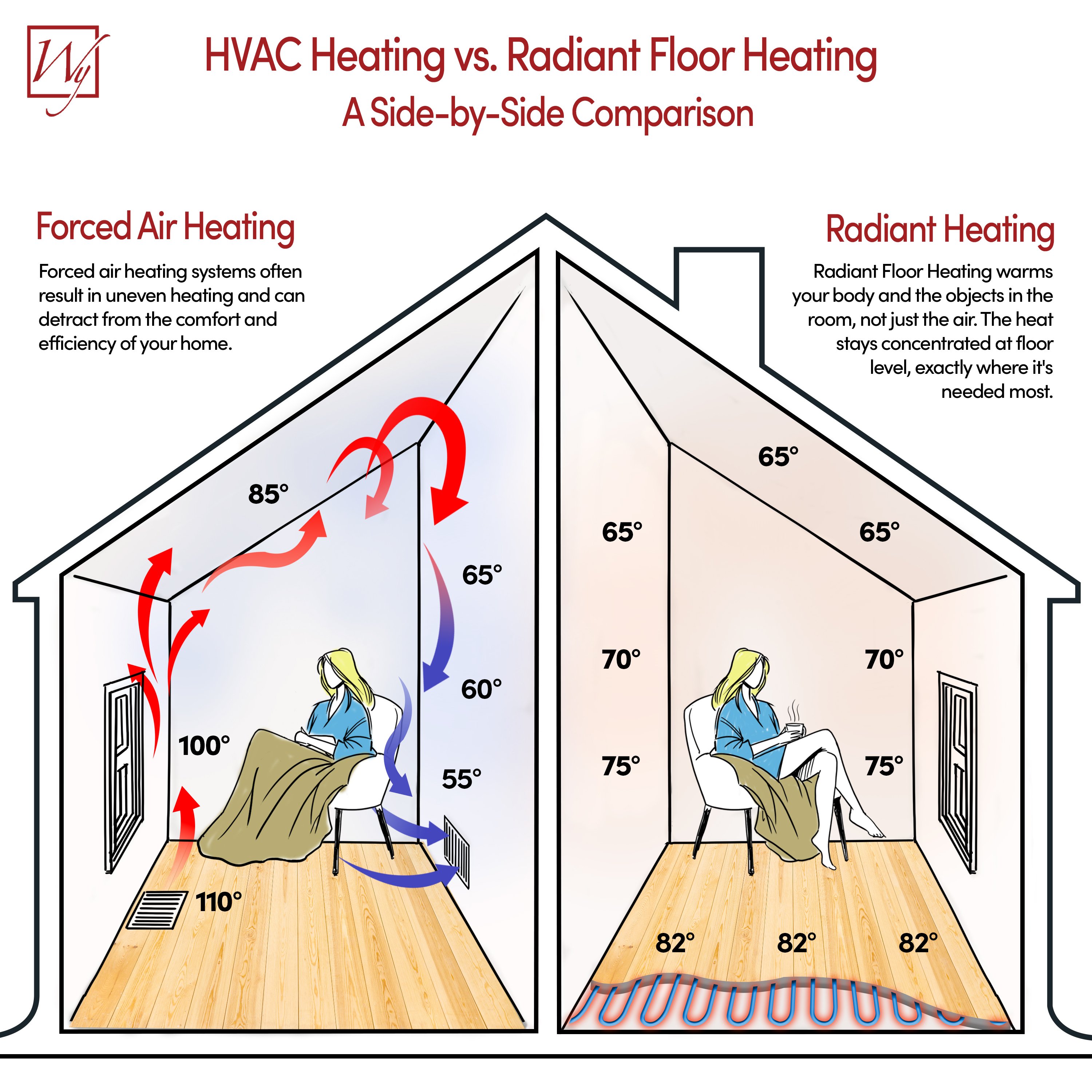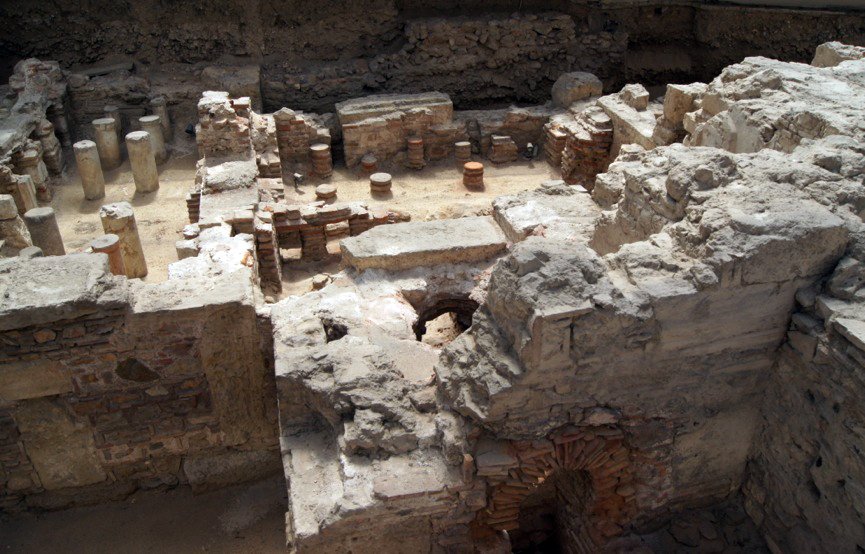How Does Radiant Heat Work: A Comprehensive Guide
What Is Radiant Floor Heating?
Radiant floor heating warms people and objects directly via infrared energy, instead of heating air first like forced-air systems. The result is even, consistent comfort with less energy lost through ducts and stratification.
Top Benefits
- Even, consistent warmth without drafts or cold spots
- Energy efficient; comfortable at lower thermostat setpoints
- Quiet operation with no fans or blowers
- Cleaner indoor air; less circulation of dust and allergens
- Zoned control to heat only the rooms you use
How Radiant Heat Works
All heat moves by conduction, convection, or radiation. Radiant floors emit infrared energy that warms surfaces directly, so rooms feel comfortable at lower air temperatures and without the drafts, noise, or duct losses common to forced air.
Where It’s Used
Radiant floor heating works exceptionally well in bathrooms, kitchens, and basements, and can be paired with radiant wall panels to supplement heat in larger rooms or rooms with lots of glass like sunrooms.
How It’s Controlled
Smart thermostats allow precise scheduling and zoning, so you can heat only the rooms you use when you use them. This improves comfort and reduces operating costs.
Typical Operating Costs
Most projects cost only pennies per hour to run. Use our Operating Cost Calculator to estimate energy use for your room size and local rates.
Contact a Radiant Heating Expert
Tell us about your project and we’ll respond within 1 business day with expert guidance and a free, no‑obligation quote.
Comparing Radiant Heat to Traditional Heating Methods
Radiant heating, when combined with proper insulation, offers several key advantages over traditional forced-air systems, such as improved comfort in varying humidity conditions, making it a superior choice for energy efficiency, home comfort solutions, and design flexibility. For a deeper understanding of how radiant heat works, consider the direct warming effect of infrared waves on surfaces, which maximizes energy efficiency.
Radiant Heat vs. Forced Air
Forced‑air systems warm the air and push it through ducts with fans, which can lead to drafts, noise, and temperature stratification (warm ceilings, cool floors). Radiant floors warm the people and surfaces in the room directly, delivering even comfort right where it’s felt most and eliminating duct losses. Radiant is also easy to zone room‑by‑room for targeted comfort.
Curious about the differences between radiant heating and forced air? Read our detailed comparison guide to see which system is best for your home.
Why Homeowners Choose Radiant
- Up to 25% more efficient than forced air (no duct losses)
- Uniform heat across the room—no drafts or cold spots
- Whisper-quiet operation
- Better indoor air quality for allergy-sensitive homes

Choosing the Right Radiant Heating Solution: Electric vs. Hydronic
Radiant floor heating systems come in two primary types: electric and hydronic. Both provide efficient, consistent warmth by heating the floor directly, but they differ in installation, cost, energy efficiency, and application. In this section, we compare electric vs. hydronic radiant heating, highlighting the unique advantages of each method for energy-saving underfloor heating.
Electric Radiant Floor Heating
Electric radiant heating uses resistance heating cables or pre-configured heating mats installed beneath the flooring, which require minimal maintenance to operate efficiently.
- Easier and more affordable to install compared to hydronic systems
- Great for zoned heating – you can heat specific rooms instead of the entire home
- Fast to warm up – ideal for scheduled heating in high-use areas like bathrooms, kitchens, and basements
- Best suited for renovations and retrofits since they don’t require major infrastructure changes
While electric systems may have lower installation costs, they can be more expensive to operate depending on local electricity rates. However, by effectively integrating a smart thermostat, you can zone heat areas and reduce energy waste by only warming rooms you actively use.
Hydronic Radiant Floor Heating
Hydronic radiant heating systems circulate heated water mixed with antifreeze through tubing beneath the floor.
- More energy-efficient for whole-home heating
- Compatible with multiple heat sources (gas boilers, solar panels, heat pumps, and geothermal systems)
- Cost-effective in the long run for new builds, especially for larger homes and commercial buildings
- Capable of both heating and cooling, unlike electric systems
However, hydronic systems have higher upfront costs due to the need for boilers, pumps, and complex piping installation. They also take longer to heat up, meaning if you use a programmable thermostat for scheduled heating, the response time may not always be ideal, making them sometimes less attractive for fast-response energy-saving radiant underfloor heating solutions.
Electric Floor Heating Systems
Explore options by room and flooring on our Electric Floor Heating Systems page. Compare products, use the Product Selector, and get pricing with the Quote Builder.
Why Install Electric Radiant Floor Heating?
-
-
Energy-efficient operation
Zoned heating lets you warm only the areas you use. -
Compatible with most flooring types
Works with tile, vinyl, laminate, engineered wood, and carpet. -
Easy installation options
Choose from pre-configured mats, loose cable, or foil-based heating. -
Silent, maintenance-free performance
No noisy blowers or circulating allergens. -
Precise, room-by-room control
Programmable thermostats provide scheduling and zoning for optimal comfort and efficiency.
Electric Floor Heating Cost
Curious about pricing? Get an instant estimate with our Quote Builder to find the best system for your space and budget. Compare options, see cost estimates, and get expert recommendations—all in just a few clicks!
From Rome to Your Home; The Evolution of Underfloor Heat
Radiant heating has been warming homes for thousands of years, evolving from ancient hypocausts to today’s energy-efficient electric systems. While modern technology has refined the process, the core principle remains the same—warming people and objects directly for consistent, comfortable heat through efficient underfloor heating solutions.
Ancient Origins: The First Radiant Heating Systems
The concept of radiant heating dates back to early civilizations, where people used natural heat sources to stay warm. Early humans chose sun-exposed caves to retain heat overnight, and over time, more structured heating solutions emerged.
The Roman Hypocaust: The Original Underfloor Heating

The ancient Romans pioneered underfloor heating with their hypocaust systems—a revolutionary method where heated air was circulated beneath stone floors to warm entire rooms.
- The Baths of Caracalla – A large-scale hypocaust system for public bathhouses
- Pompeii’s villas – Archaeological digs revealed extensive radiant heating in Roman homes
- Emperor Nero’s palace – Luxury residences and even barges featured heated floors
These systems remained the gold standard for centuries until radiant heating reemerged in the 18th and 19th centuries.
The 18th & 19th Century: The Return of Radiant Heating
After the fall of Rome, radiant heating disappeared for centuries. However, in the late 1700s, engineers rediscovered its potential.
- 1790 – Sir John Stone installed one of the first hot water heating systems at the Bank of England, using large pipes to distribute warmth.
- 19th Century – Steam and hot water radiators became common, evolving into the cast-iron radiator systems still seen in older buildings.
While effective, these systems were bulky and visually unappealing, paving the way for embedded radiant heating.
The Birth of Modern Radiant Heating
The 20th century marked the transition from bulky radiators to hidden heating systems.
- 1908 – Professor Arthur H. Barker developed embedded hot water pipes, laying the foundation for panel radiant heating.
- 1930s – The Liverpool Cathedral installed one of the first large-scale radiant floor heating systems, known as the “Romana” method.
- 1950s – Hydronic radiant heating was introduced in residential construction, using hot water tubing embedded in concrete slabs.
While hydronic systems offered efficient warmth, they required boilers, pumps, and extensive piping, making installation complex and costly. This led to the next major innovation—electric radiant heating.
The Rise of Electric Radiant Heating
As technology advanced, electric radiant heating emerged as a simpler, more efficient alternative to hydronic systems.
- 1995 – Julia Billen, a pioneer in the industry, began working with electric radiant heating.
- 1999 – Julia founded WarmlyYours Radiant Heating, a company dedicated to making radiant floor heating more accessible and efficient for homeowners and professionals.
- 2000s-Present – Electric radiant floor heating became one of the most energy-efficient heating options, with thin, easy-to-install heating cables and mats.
Electric radiant floor heating eliminates the need for bulky boilers or extensive plumbing. Smart thermostats now allow homeowners to control heating zones and maximize energy efficiency. Radiant heating is now found in homes, luxury resorts, and commercial buildings worldwide.
Radiant Heating Today: A Modern Comfort Inspired by Ancient Innovation
From Roman bathhouses to high-tech electric floor heating, radiant warmth has stood the test of time. Advances in technology, energy efficiency, and smart home integration have made radiant heating more accessible and affordable than ever.
Thinking about adding radiant heat to your home?